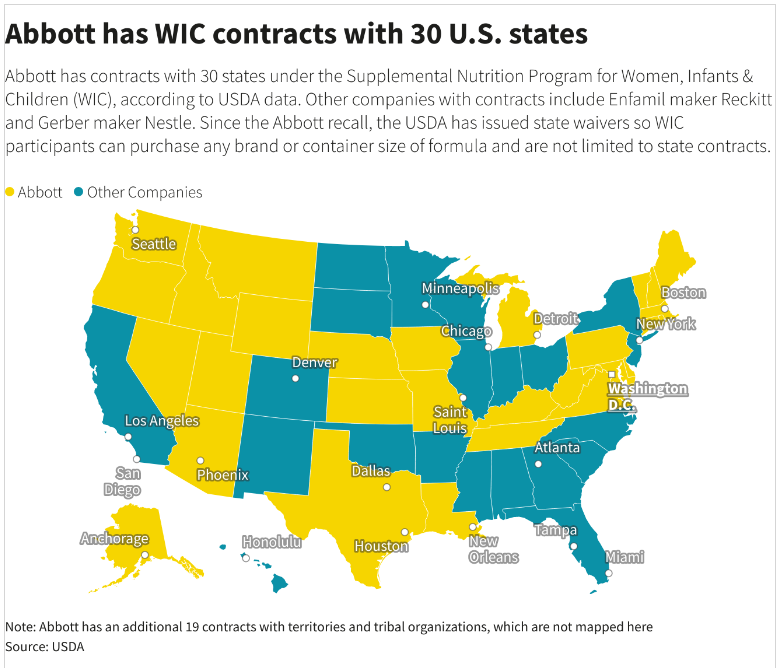The Formula Shortage: Economic Impact and Policy Responses

Table of Contents
Author(s)
Alexandra E. Bello
Former Research ManagerShare this Publication
- Print This Publication
- Cite This Publication Copy Citation
Alexandra E. Bello, “The Formula Shortage: Economic Impact and Policy Responses” (Houston: Rice University’s Baker Institute for Public Policy, June 23, 2022).
A New Health Threat
With the average out-of-stock rate for baby formula reaching 43% nationwide, parents and policymakers are scrambling for solutions [1]. CVS, Walgreens and Target have all imposed purchasing limits on formula — if they even have it in stock. The problem is even worse for premature babies who have higher caloric needs, and those with allergies [2]. Desperate to feed their children, some parents are driving several hours in search of formula, while others are resorting to informal milk swaps. Without the screening and processing a milk bank provides, milk swaps can introduce babies’ systems to bacteria, drugs or even life-threatening infections, like HIV [3]. In the post-pandemic world, the lack of formula is creating a new health threat.
The Formula Monopoly and WIC
Abbott Laboratories closed in February 2022, after infants linked to their powdered formula died. Between December 1, 2021, and March 3, 2022, the FDA received nine reports of infant deaths among babies who were fed powdered infant formula manufactured by Abbott Nutrition [4]. Although a link has not been confirmed, Abbott’s voluntary recall exposed a fragile formula market, in which 90% of sales are controlled by just four companies (Abbott, Perrigo, Nestle SA and Mead Johnson) [5]. A concentrated market did not happen by accident. Instead, it is the result of government policy.
Figure 1

The USDA’s Special Supplemental Nutrition Program for Women, Infants, and Children, commonly known as WIC, is responsible for nearly half of formula sales in the United States. Individual states are required to award a formula contract to the lowest bidder, leaving one company in charge of the state’s WIC formula allocation [5]. Companies with the WIC contract for a particular state get the most shelf space and the most recommendations from pediatricians [6]. A study by the U.S. Department of Agriculture (USDA) showed that when a manufacturer gains a state WIC contract, it boosts sales of its product to all consumers. The effect is dramatic, too. In 2007, California switched its WIC contract from Abbott to Mead Johnson, subsequently dropping Abbott’s market share from 90% to 5% across both WIC and non-WIC consumers [6]. With WIC contracts in place, there is little incentive for brands to compete. As a result, the market is vulnerable to shortages.
To make matters worse, U.S. trade and regulatory restrictions make importing formula difficult. Formula made in Europe fails to meet FDA labeling rules, preventing its import entirely. The United States-Mexico-Canada Agreement of 2020 restricts formula from Canada in an effort to protect U.S. dairy farmers [7]. Additionally, a 17.5% tax applies to all imported formula [5]. The combination of heavy restrictions and WIC contracts has created a market where barrier to entry is too high for new formula makers to win. In the past 15 years, only one new formula manufacturer has entered the U.S. market [5]. The new competitor, ByHeart, launched on March 23, in the midst of the shortage. Unfortunately, the demand is far too great for one start-up to handle.
Policy Solutions
Defense Production Act and Operation Fly Formula
In hopes of ramping up production, the White House invoked the Defense Production Act (DPA), which requires suppliers to “direct needed resources to infant formula manufacturers before any other customer who may have ordered that good.” According to a statement released by the White House, invoking the DPA is intended to “increase production and speed up supply chains” [9]. A re-opening agreement between regulators and Abbott Laboratories was reached four weeks ago, but consumers are still waiting for the re-opening. Abbott Laboratories estimates that it will take 8-10 more weeks for their product to reach stores after their facility reopens [10].
As U.S. manufacturers struggle to catch up, the White House launched Operation Fly Formula, which involves the Department of Health and Human Services (HHS), USDA and Department of Defense (DOD) shipping infant formula from overseas to the United States. The White House has reiterated that the formula meets U.S. standards, and is safe. On June 9, 2022 HHS flew 110,000 pounds of Nestlé NAN SupremePro Stage 1 infant formula from Cologne, Germany to Fort Worth, Texas. In total this equals approximately 1.6 million eight-ounce bottles, which were distributed across the country [11]. On June 15, 2022, the White House announced it would be facilitating air shipment of 548,000 eight-ounce bottle equivalents of Nestlé Alfamino® and Alfamino® Junior specialty infant formula within the week [12].
H.R. 7790 and H.R. 7791
In addition to White House initiatives, two House bills related to the formula shortage have been filed. The first bill, H.R. 7790, would give the FDA $28 million in emergency spending funds to hire staff. While the bill passed in the House, it still faces scrutiny in the Senate [13]. Opponents are unconvinced that hiring more staff will improve production that’s desperately needed to fill shelves.
H.R. 7791 gives the USDA the ability to issue a narrow set of waivers in the event of a supply disruption. In this scenario, the waivers allow WIC participants to purchase formula from any producer rather than be limited to one brand (which may be out of stock). This is significant as the WIC assistance program accounts for nearly half of infant formula sales in the U.S. With overwhelming bipartisan support, the bill passed unanimously in the Senate on May 19, after a 414-9 vote in the House of Representatives [14].
Broader Impact
In the post-pandemic world, it’s been suggested that overseas manufacturers should relocate to American soil as a way to strengthen the supply chain. Although nearly all formula was being produced in the United States, parents are still experiencing a stressful, prolonged shortage. In fact, parents are relying on international suppliers to feed their babies. The Biden-Harris administration has secured commitments to import 130.7 million bottles of formula to feed American infants [15]. A resilient supply chain does not mean mandating manufacturers be located in the United States. Instead, it includes both domestic and international suppliers as a means of diversification to reduce the likelihood of shortages [16].
Furthermore, the WIC program is being called into question. Though WIC claims to “safeguard the health of low-income women, infants, and children,” its contract system has left new parents scrambling to meet their babies’ most basic need: formula [17]. It is clear that the current contract system should be evaluated. The infant formula shortage highlights the need for improved policy that promotes healthy competition among suppliers at local and international levels.
Endnotes
1. Bowman, Emma. “More baby formula shipments arrive from overseas in an effort to ease the shortage.” NPR, May 28, 2022, https://www.npr.org/2022/05/28/1101931160/baby-formula-shortage-overseas-shipments.
2. Pearson, Catherine. “How am I Going to Feed her? Parents of Premature Babies Struggle Amid Formula Shortage.” The New York Times. June 6, 2022, https://www.nytimes.com/2022/06/06/well/family/nicu-premature-babies-formula-shortage.html.
3. “Parents Think It’s Safe to Share Breast Milk. Here’s Why That Makes Experts Nervous.” Healthline, October 25, 2019, https://www.healthline.com/health-news/parents-think-its-safe-share-breast-milk-it-makes-experts-worried.
4. Reiley, Laura. “New documents show more claims of baby formula illness and death.” The Washington Post. June 10, 2022, https://www.washingtonpost.com/business/2022/06/10/baby-formula-deaths-abbott/.
5. Muller, Madison and Nylen, Leah. “How US Baby Formula Monopolies Failed Families.” Bloomberg, May 20, 2022, https://www.bloomberg.com/news/articles/2022-05-20/baby-formula-shortage-shows-risk-of-us-industry-concentration.
6. Horsley, Scott. “How the U.S. got into this baby formula mess.” May 19, 2022, https://www.npr.org/2022/05/19/1099748064/baby-infant-formula-shortages.
7. United States-Mexico-Canada Agreement Implementation Act, H.R. 5430, https://www.congress.gov/bill/116th-congress/house-bill/5430/text.
8. “Biden invokes the Defense Production Act for the baby formula shortage,” NPR, https://www.npr.org/2022/05/18/1099937734/biden-invokes-defense-production-act-for-baby-formula-shortage.
9. Gretler, Corinne. “Abbott in Pact with FDA on Steps to Re-open Baby-Formula Plant.” May 16, 2022. https://www.bloomberg.com/news/articles/2022-05-16/abbott-in-pact-with-fda-over-steps-to-reopen-baby-formula-plant
10. The White House. “FACT SHEET: President Biden Announces New Actions to Address Infant Formula Shortage.” May 18, 2022, https://www.whitehouse.gov/briefing-room/statements-releases/2022/05/18/fact-sheet-president-biden-announces-new-actions-to-address-infant-formula-shortage/.
11. The White House. “Fifth Operation Fly Formula Mission.” June 6, 2022, https://www.whitehouse.gov/briefing-room/statements-releases/2022/06/06/president-biden-announces-fifth-operation-fly-formula-mission/.
12. The White House. “President Biden Announces Seventh Operation Fly Formula Mission.” June 15, 2022, https://www.whitehouse.gov/briefing-room/statements-releases/2022/06/15/president-biden-announces-seventh-operation-fly-formula-mission/.
13. Infant Formula Supplemental Appropriations Act, H.R. 7790, https://www.congress.gov/117/bills/hr7790/BILLS-117hr7790pcs.pdf.
14. The White House. “H.R. 7791, Access to Baby Formula Act of 2022.” May 21, 2022, https://www.whitehouse.gov/briefing-room/legislation/2022/05/21/bills-signed-h-r-7691-and-h-r-7791/.
15. The White House. “Addressing the Infant Formula Shortage,” https://www.whitehouse.gov/formula/.
16. Horsley, Scott. “Economists are weighing in on America’s baby formula shortage.” May 17, 2022, https://www.npr.org/2022/05/17/1099587513/economists-are-weighing-in-on-americas-baby-formula-shortage.
17. “About WIC: WIC’s Mission.” October 10, 2013, https://www.fns.usda.gov/wic/about-wic-wics-mission.
This material may be quoted or reproduced without prior permission, provided appropriate credit is given to the author and Rice University’s Baker Institute for Public Policy. The views expressed herein are those of the individual author(s), and do not necessarily represent the views of Rice University’s Baker Institute for Public Policy.


